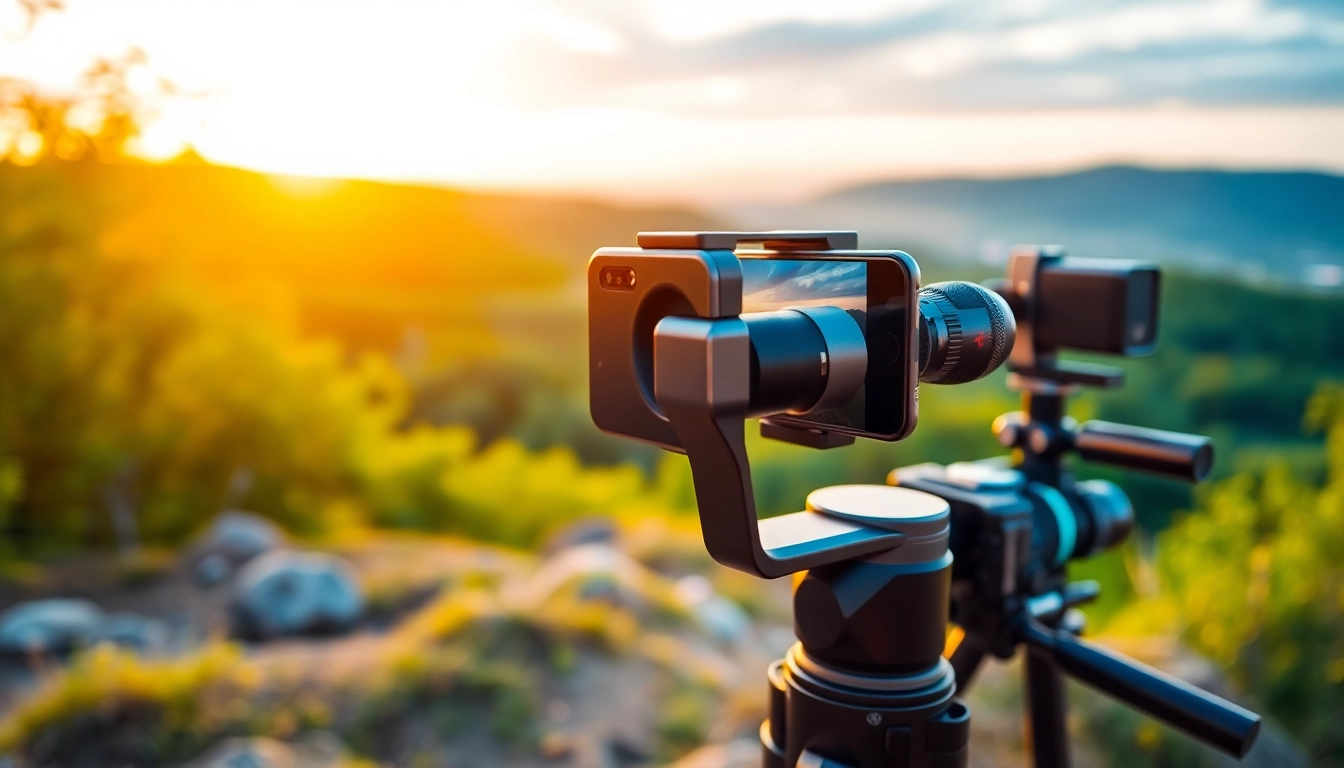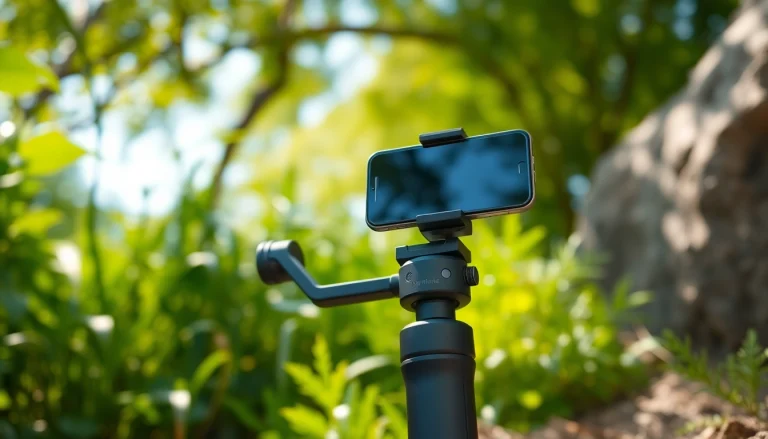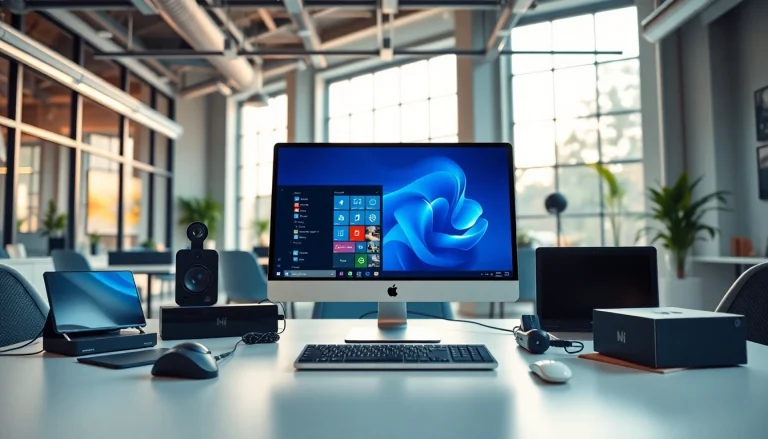Understanding the Basics of a Gimble
Definition and Functions of a Gimble
A gimble is a mechanical device containing rings or frames that pivot to keep an object steady as it moves. It enables rotation around one or more axes, functioning as a stabilizing mechanism that maintains balance. Originally found in maritime navigation and aerospace applications, gimbals have transcended their traditional roles and have become quintessential in modern videography and photography, providing smooth captures and dynamic angles without the undesirable shakiness of handheld shooting.
How Gimble Works: The Technology Behind It
The fundamental working principle of a gimble is based on isolating the camera (or smartphone) from unwanted motions. This is achieved through a system of motors and sensors in electronic gimbals, which actively counteract movements caused by the operator’s hands or other external factors. Typically, a 3-axis gimble offers tilt, pan, and roll stabilization, which allows for smooth movement in varied filming conditions. The sensors detect any shift or jerk in the camera’s position and adjust the motors to maintain the desired framing, enabling cinematographers to focus on their creative vision rather than camera shake.
Types of Gimbles Available for Different Uses
Gimbals can be classified based on their design and application:
- Handheld Gimbals: Most popular among amateur videographers, these are portable and user-friendly, perfect for smartphones and lightweight cameras.
- Camera Gimbals: Designed specifically for DSLRs or mirrorless cameras, these gimbals offer advanced stabilization and payload capacities.
- Drone Gimbals: Specialized for aerial photography, these gimbals are optimized to minimize the effects of wind and provide smooth footage while flying.
- Wearable Gimbals: Designed for actions sports or scenarios requiring hands-free shooting, these are mounted on helmets or body harnesses.
Choosing the Right Gimble for Your Needs
Factors to Consider When Selecting a Gimble
Choosing the right gimble depends on multiple factors:
- Weight Capacity: Ensure that the gimble can support your camera’s weight, as exceeding this will lead to performance issues.
- Battery Life: Evaluate how long the gimble can operate on a single charge, especially if filming over extended periods.
- Size and Portability: Consider how easy it is to transport, especially if you will be carrying it for outdoor shoots.
- Ease of Use: Look for models with intuitive controls that align with your level of experience.
Guidelines for Matching a Gimble with Your Equipment
When selecting a gimble, it’s crucial to consider the type of equipment you’ll be using. If you own a smartphone with advanced camera capabilities, a lightweight handheld gimble will suffice. Conversely, for DSLRs with long lenses, invest in a higher-capacity, often heavier, gimble. Pay attention to features that may enhance integration, such as the compatibility of software for adjusting settings or the ability to attach accessories like external microphones or lights.
Common Mistakes to Avoid When Buying a Gimble
Many buyers make the following mistakes when purchasing a gimble:
- Ignoring Weight Limits: Always check the payload specifications to avoid damaging your camera setup.
- Overlooking Battery Specifications: Ensure the battery life suits your shooting schedule, particularly for longer filming days.
- Choosing the Wrong Type: Understand the intended use of the gimble; purchasing a device for an action camera when you primarily shoot with a DSLR will hinder performance.
Setting Up Your Gimble: Step-by-Step Guide
Essential Preparations for Using Your Gimble
Before you can harness the full power of a gimble, there are several preliminary steps to undertake:
- Unpack the gimble and ensure all components are included in the package.
- Charge the gimble fully to avoid interruptions during use.
- Check for any necessary firmware updates that may enhance performance or functionality.
- Familiarize yourself with the controls and features through the manual provided.
Calibration and Balancing Your Gimble
Calibration is critical for optimal performance. Balancing your gimble can be done following these guidelines:
- Mount your camera or smartphone securely onto the gimble and ensure it is properly seated.
- Adjust the camera’s position on the gimble until it perfectly balances; when held, it should not flip in any direction.
- Utilize any calibration tools provided by the manufacturer to enhance precision.
Initial Testing and Fine-Tuning Settings
After setup, perform initial testing by capturing sample footage. This will help identify any adjustments needed in terms of sensitivity or stability settings based on your shooting style. Most gimbals have tuning features that allow you to adjust how aggressively they respond to movements.
Best Practices for Using a Gimble in Videography
Techniques to Achieve Smooth Shots with a Gimble
Achieving smooth footage requires the use of appropriate techniques. Here are a few tips:
- Walk Smoothly: When moving with the gimble, aim for a gentle stride. Consider practicing the “ninja walk”, which involves bending your knees slightly, using slower movements to minimize shake.
- Utilize Dynamic Movements: Experiment with panning or tilting, but always ensure you adjust your speed to match the sensitivity settings of your gimble.
- Practice Static Shots: For static shots, consider using lock mode to maintain focused framing of your subject without any motion.
Maintaining Stability During Dynamic Movement
Dynamic scenes often present the most challenge. To maintain stability:
- Engage lock mode during fast transitions to ensure the frame focuses on the subject.
- Use two hands for added stability, allowing for finer adjustments while maintaining control.
- Adopt consistent movement patterns, always aiming to create fluid transitions.
Tips for Filming in Various Environments
Different environments will require you to adapt your filming techniques:
- Indoor Filming: Pay attention to lighting; an external light source might be necessary for reduced shadows.
- Outdoor Filming: Wind can disrupt stability; always start with the lowest setting and counterbalance with weights if necessary.
- Action Shots: Prioritize lightweight setups to minimize drag and increase maneuverability.
Advanced Techniques and Trends in Gimble Usage
Integrating Automation Features for Enhanced Control
Modern gimbals often feature automated functionalities that enhance creative control. These may include:
- Follow Mode: This allows the gimble to automatically follow the subject based on the chosen settings.
- Time-lapse and Hyper-lapse Modes: Some gimbals facilitate intricate time-lapse shots by automatically changing angles over set durations.
Latest Innovations in Gimble Technology
Advanced gimbals are now equipped with smart features, such as AI tracking capabilities, which enable the device to identify and follow subjects without manual adjustments. This represents a significant leap in gimbal technology, catering to content creators who require versatility in fast-paced environments.
Future Trends: What to Expect from Gimble Developments
As technology continues to evolve, expect to see:
- Further miniaturization of gimbals, making them lighter and more portable without compromising on performance.
- Increased integration with virtual reality and augmented reality applications, where stabilization is critical.
- Enhanced software applications that pair with gimbals for data analytics to help videographers understand their shooting patterns and improve their skill sets.








